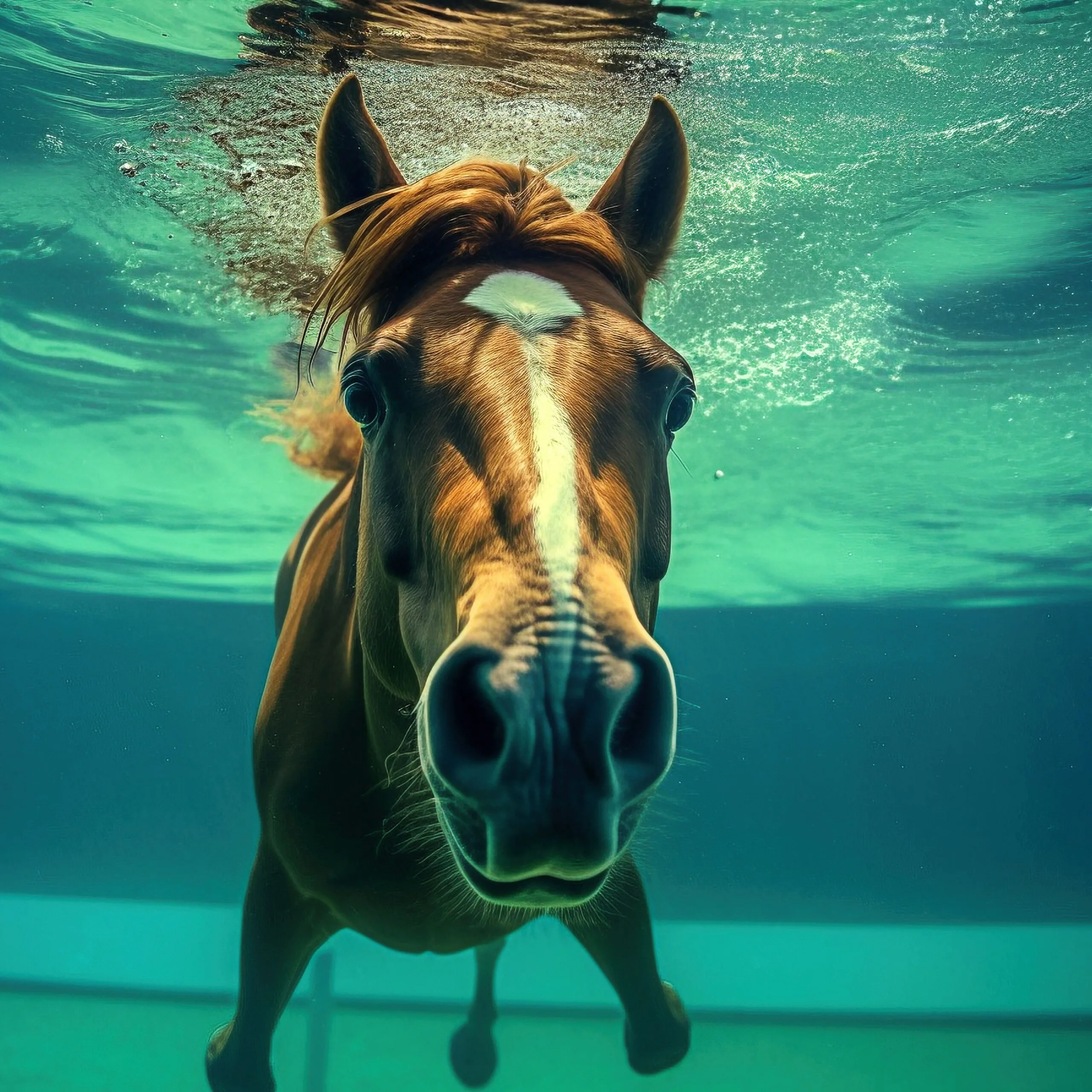Horses are great swimmers. Some horses even love playing in the water. However, other horses find the water unsettling, especially if they can’t see the bottom. If your horse is a bit scared of the water, don’t worry, there are a few ways you can help reduce their anxiety.
In this article, you will discover:
- Horses swim pretty well! Here’s why
- How to go Swimming with a Horse
- Why some people want their horse to be able to swim
- 3 Reasons some horses are afraid of the water
- How to help your horse overcome their fear
Horses Can Swim
Horses can swim very well. Because horses have large lungs that fill with oxygen, they naturally float in deep water. But they don’t just float. Horses that find themselves in water too deep to walk in will instinctively start swimming.
When a horse starts to swim, it will begin to paddle in a motion similar to a trot. It is not necessarily fast (no more than 2.5 mph). But it is effective and allows horses to survive quite well in the water if needed. Swimming is sometimes used as a tool to help injured horses recover and rehabilitate muscles.1

FIrst: Choosing the perfect swimming spot 🌊🐴
Not all bodies of water are safe for fun for horses to swim in. And asking your horse to charge into a deep body of water without first introducing them to smaller water crossings often creates a bad horse swimming experience.
| Safe Places to Swim with a Horse | Unsafe Places to Swim with a Horse |
|---|---|
| 1. Calm lakes and ponds | 1. Fast-moving rivers |
| 2. Gentle streams | 2. Strong ocean currents |
| 3. Shallow creeks | 3. Floodwater |
| 4. Equine rehab swimming pools | 4. Water with submerged obstacles |
| 5. Saltwater with little to no current |
How to have a blast swimming with your horse:
Shallow versus deep water for horse swimming 🌊🐎
Horses can swim in very deep water, however, horse owners should avoid deep water with strong currents. While horses are buoyant and naturally pretty good swimmers, horses should not swim in fast-moving water such as rivers, strong ocean currents, or floodwaters. Like cars, horses can easily be swept away by swiftly moving water even just a few feet deep.
Listen to Your Horse
Unlike cars, most horses have a good instinct that helps them know when water is unsafe to swim in. If your horse strongly rejects your cues asking them to swim in deep water, it’s often best to respect the horse’s instinct to avoid that water.
Train your horse to enjoy water 💧🐴
Some horses naturally love water (I had a chestnut mare in my 20s who couldn’t be trusted not to climb in a horse trough bigger than 10 gallons!) Other horses may appear to have a deep-seated fear of even shallow puddles of water.
Having fun swimming with your horse depends on developing their comfort with water.
Steps to training a horse to enjoy swimming 🏊♂️🐎
- Get them used to puddles
Use a garden hose in a safe, comfortable area where your horse is familiar with the footing, to create shallow puddles. Walk, trot, and canter your horse through the puddle, being prepared for the horse to potentially shy. - Introduce shallow water crossings
Before going swimming in deep water with the horse, introduce them to carrying a rider into shallow, safe water. Creek crossings and shallow rivers on trail rides are ideal for this type of water training. Many horses will prefer to jump over a narrow creek, so wide, flat, and slow-moving portions of a creek or river are best for this type of water training. - Approach and retreat deeper water with a confident equine buddy
Even with plenty of splashing around in shallower water, your horse might not be ready to go swimming with you. As a final step for getting your horse more comfortable with deeper water and actual swimming, visit the waterfront with a horse that is comfortable and experienced swimming with a rider. There, you can encourage your horse to go into deeper and deeper water until you are fully submerged and swimming with your horse.
Things to know about swimming with horses 🌊🐴
How horses swim: Horses swim by moving their legs back and forth to tread water – similar to trotting. Horses almost always keep their head above water while swimming. A horse swims in a very similar way to how a dog paddles in water.
Swimming with a rider: Swimming with the rider is extremely physically challenging for a horse and unexpected movements – such as a horse trying to roll – can make it difficult for a rider to stay mounted. While many riders want to swim with their horse, wading or splashing in shallow water (such as the surf on a beach) is often more fun.
Horses swim very slowly: While on land, horses are fast runners, horses swim slowly! The swimming speed of the horse is estimated to be around 2 to 3 miles an hour (compare that to 25 to 30 mph galloping on land!).
Horses swim well enough that you can ride them while they swim. However, if you ride them while swimming, you should keep a loose grip on the reins so they can move their head freely. You also need to ensure you don’t get in the way of their movements. For example, a saddle may restrict their back movement, so you may want to remove it before going for a swim.
Remember, even though a horse can swim well, it is hard work. So, keep an eye on your horse and give them enough breaks from swimming to ensure they don’t become exhausted and injure themselves.
Many Horse Owners Want Their Horses To Be Able To Swim
The main reason owners like their horses to be able to swim is because swimming is great exercise. When a horse swims, they use many muscles that help build strength. It also alleviates a lot of the pressure on their joints. Because it is easier on a horse’s joints, water therapy is great for horses with leg injuries. It allows the horse to use their injured leg without the risk of further injury.
Why Are Some Horses Afraid of the Water
There are several reasons that your horse may not like getting into the water.
- Horses have poor depth perception, which means that they can’t always tell how deep the water is
- If the water is dark or muddy, they may not like that they can’t see if there is danger below the surface
- They may have had a bad experience in the past and developed a fear of water
- They don’t like getting wet. Just like people, horses have things they do and don’t like. For example, some people hate going to the beach because they don’t like to get their hair wet. Horses are the same, and some just don’t like the feel of being wet.

How Can You Help Your Horse Overcome Their Fear of Water?
In most cases, giving them a very slow introduction to water is best. However, if you choose to (re)introduce your horse to water, you need to:
- Make sure you use a loose grip on the reins so that they can move their head.
- Don’t force them to get into the water.
- Let them stop and get comfortable before asking them to continue if they take two or three steps in and don’t want to go further.
- Stay calm. If you get angry or frustrated with your horse for not getting in the water, your horse will feel your tension and become more scared of entering the water. Avoid taking a hot horse near water, as they might be more unpredictable.
- Don’t make them stay in the water if they get spooked. If your horse feels like they cannot escape, they will be more unwilling to enter the water in the future.
- Get them a buddy. If you have a friend with a horse that loves to swim, have them come over and swim with you and your horse. Your horse may be more comfortable entering the water if they see another horse having fun.
Remember that different bodies of water can evoke different levels of fear for your horse. For example, the pond up the road may have crystal clear water that is more inviting than one with dark water. Your horse will tell you if they are scared, so always make sure you are listening.
Final Thoughts on Horses Swimming
Horses are capable swimmers, and it can be a lot of fun to see them enjoy the water. However, if you haven’t seen your horse swim before, remember that they may find the experience scary. So, take it slow and make sure that your horse has as much fun as you!
- Rattenhuber, S., Benz, H., Gajewski, Z., & Carstanjen, B. (2012). Swim training as therapy of neurogenic induced unilateral shoulder instability in three horses. Pferdeheilkunde, 28(6), 665-7. [↩]

